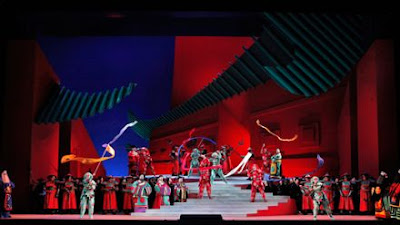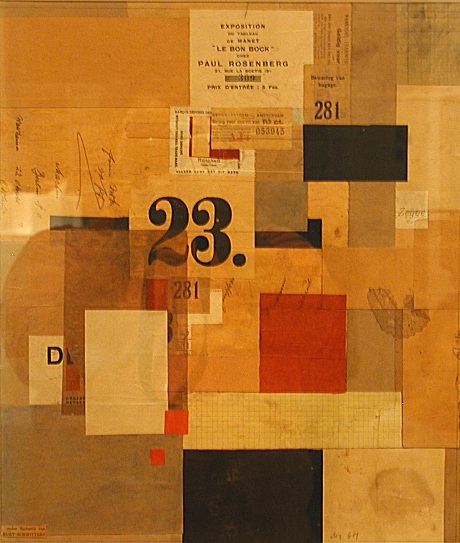David Hockney - Stage Design for 'Turnadot'
'Sky Scrapers and Subway' 1930
Sketch for the Mobile Scenery of "The New Babel" 1930
Fortunato Despero - 'Sky Scraper and Tunnel' 1930
The glory of technology! The fascination of speed! The thrill of new products! For the creators of the Futurist movement of the early twentieth century, this was what inspired them. Fortunato Despero joined the furists late but was inspired by it ideas throughout his career. This is a piece of Despero's theatre design - this stage set was never built. They represent the sense of vertigo in a city, sometimes by the means of skyscraper shapes placed in precarious perspective at acute angles, sometimes by showing the hidden underground subway system. Despero described a mass of people as "crowd confetti, crowd ants, crowds of human sand flowing, slipping, falling apart". This indicated that in the midst of this mechanical paradise there is a sense of alienation and solitude.
Kurt Schwitters - 'Mz 601' 1923
Kurt Schwitters created collages that were purely abstract and were made up of fragments of detritus from the streets. He called these collages Merz - taken from the words left on a fragment of torn paper. In this collage Schwitters has used a series of squares laid next to and on top of one another. Fragments of paper are joined by fragments of letters and numbers - the overall composition is dominated by a large number 23 just left of center. The image could be described as having a random nature but there also seems to be movement, animation and rhythm. There could be an order to this chaos - as if Schwitters has used elements of the golden rectangle in his work.
These photographs above were taken of Schwitters 'Merzblau'. From 1923 Scwitters began work on what he regarded to be his life's work. In his home he began to place collages on the walls, eventually adding and expanding them all over his home. He gradually connected them with string, wire, wood and plaster. His home eventually became a 'Merzblau' (a Merz Building) - both his home and a giant three dimensional sculpture/installation. The flat angles from his collages became sculptural forms, wall became distorted planes like a german expressionist stage set. As with many key German artists Schwitters fled to escape the Nazis' in 1937. Never one to be put off by the tyranny of fascism Schwitters built more Merzblau in Norway (1937 -1940) and Cumbria, England (Merz Barn 1947).
The three dimensional angles of Schwitters Merzblau and German expressionism are found in this visually rich building. This is the Nestle Chocolate Museum designed by Rojkind. The exterior is made up of rich primary red prefabricated sections pieced together. Many of the skins of buildings combine different materials like a Scwitters collage. When Collage moves into three dimensions it becomes an Assemblage.
In these two scenes from 'The Cabinet of Dr Calligari' the use of dramatic diagonal lines to break up the composition is a characteristic of GermanExpressionism.
'Potsdamer Platz' 1914 Ernst Ludwig Kirchner
In this painting by Ernst Ludwig Kirchner you can see the warped perspective of the city streets almost tipping the scene over. You can see how Kirchers dramatic distortion of space was used in the stage sets of German cinema. Kirchner was one of the prolific of the German Expressionist artists who were opposed to the academic art that surrounded them.
Jaromir Funke 'Abstract photo' 1928-29
These images show how German expression not only took the form of painting, printing, film but also avant guard photography. Jaromír Funke (1896–1945) was one of the foremost photographers of the 1920s and 1930s in Czechoslovakia, a country that stood at the forefront of creative photography during these two decades. In many ways he was an amateur in the true sense of the word. These simple light experiments combine diagonal lines and triangles with circles to create dramatic compositions. The use of strong contrast between the areas of light and dark adds to this dramatic effect. The influence of German expressionism has reached art (Neo Expressionism), animation (Lotte Reiniger's - fairy tale films), modern cinema (Film Noir, Sin City) and even video games (via film noir - LA Noir - here).















